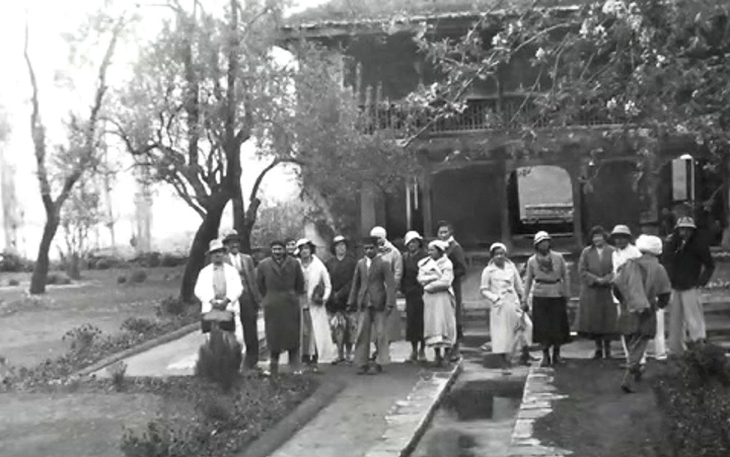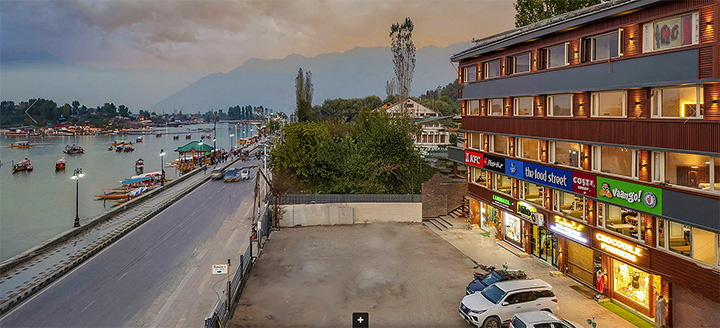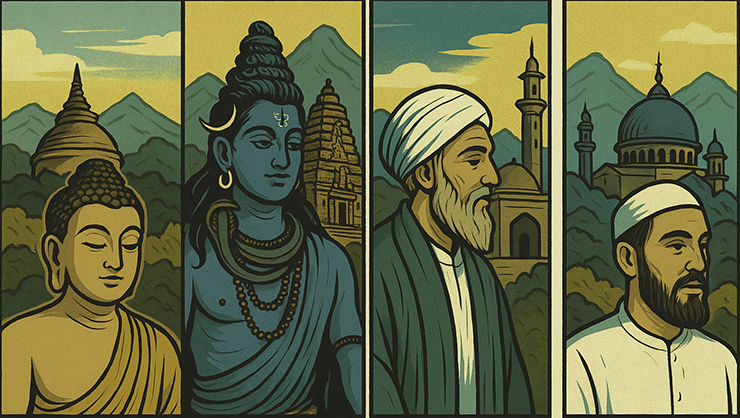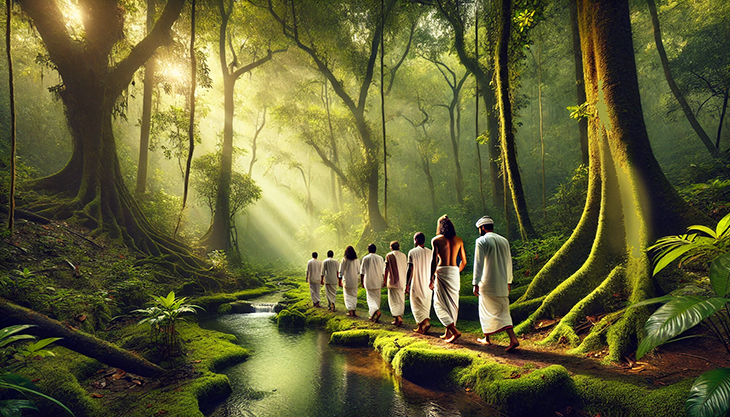| Fly to Srinagar in Kashmir | ||||||||||
Photo above: Harwan Valley, Srinagar, Kashmir, India... Pre Arrange for airport pickup from your hotel reservation in advance. Kashmir advice: it is imperative for women to dress very modestly when visiting Srinagar. Srinagar has pleasant weather during the monsoon season Check with your embassy about unrest in area.
MEHER BABA TRIP TO HARVAN and JESUS' TOMB. His tomb is in a cave. It says 'Jesu the Good Shepard' (Yuz) but has been covered by a landslide and is not identified . Baba once took the women to the village of Harvan, 1933 and showed them where he had sat in seclusion in 1929. Pointing to a place in the mountainous area, Baba made the sign of the cross and remarked: "That is where Jesus' body is buried." Baba had stated that Jesus did not die on the cross but came to India, where he spent many years wandering from place to place doing his Universal work until he dropped his body in Kashmir. Pointing to a hill, Baba revealed, "There is the place where two of Christ's apostles, Bartholomew and Thaddeus, buried his body; they had accompanied him from Palestine." "He, who had once borne the cross,
Meher Baba in Harvan. Norina Matchiabeli behind him. On their way to see the area of Jesus' Tomb. The hill can be seen from the fishery. He told them to have lunch, do a little shopping at some of the famous Kashmiri embroidry shops as well as wood carvings. On the 21st Meher Baba took them for a ride in shikaras (a type of wooden boat) to the city and went to a movie in the afternoon. 23 April 1933 was their last day in Srinagar. The weather was again cloudy and chilly; but, when it cleared in the afternoon, Meher Baba took all to the Shalimar and Nishat Gardens. 'Avatar Meher Baba Ki Jai'.
------------------------------- "The place, where I have chosen to remain in seclusion, is connected with Christ. His body is buried near here. In 1929 Baba hiked up the hill. "Saturday morning, 3 August 1929, Baba and the mandali set out for Harvan. Three times along the way he stopped by a stream to wet his feet; once he gave water to the boys from his own hands. Two small cottages were rented below the Harvan hill, one for the mandali and one for the boys. A hut for Baba was being erected 500 feet up the side of the hill. Baba was to remain in the hut and two of the mandali were to stay next to it. When they arrived at Harvan, Baba climbed up the hill to inspect the work and returned after an hour. Looking down at the valley, observing the poor villagers. Baba went up the hill at nine to inspect the work with Raosaheb, Ramjoo, and the boys. The hut was almost completed and preparations were made for Baba to sit in seclusion from the following day. The hut was very small; it consisted of a single narrow room with just sufficient space for Baba to lie down. The roof jutted out on both sides, forming a shelter for the two mandali, who were to keep constant watch outside. Baba intended to lock himself inside the room. QUOTES: From Lord Meher Online and Meher Baba. Starting on 7 August, Baba fasted during the entire period of seclusion, taking only water which was passed to him through a small window of the hut. At a fixed time each day, Baba would knock from the inside and receive the water through the window without being seen by anyone. At that time, the hills of Harvan were choice hunting grounds, abounding in tigers, bears, wolves, and other wild animals. Throughout the night, Buasaheb, Gustadji, or Chanji could hear the constant roars and rumblings from these fierce animals. The only source of protection they had was a staff to keep scorpions, snakes, and small animals away, so a fire was lit at night to keep the wild animals at bay. On 10 August, leaving the hut after sunrise, Baba went down to the mandali's cottage. Meeting with them, he unexpectedly suggested leaving Kashmir after spending only two and a half days in seclusion, and not forty as planned. Baba decided to leave Kashmir the next day. 11 August 1929, Baba and the mandali hurriedly departed from Harvan. ---------------------------------------
Buddhist Monastery, very active 2,000 years ago. Ruins now. On the outskirts of Srinagar in Harwan, lie the ruins of an old Buddhist Monastery. It is hard to imagine the importance of the site from its ruins. But this ancient monastery played a pivotal role in the history of Buddhism. The spread of Buddhism from Sarnath to the Eastern world is a testament to the religion's profound spiritual appeal and its ability to adapt to diverse cultures. The monasteries of Kashmir, as a hub of learning and a crossroad between different worlds, played a crucial role in this historical process. They not only preserved and enriched Buddhist teachings but also acted as a bridge that facilitated Buddhism's journey across Asia. This expansive spread of Buddhism contributed to the rich tapestry of cultures and philosophies in the Eastern world, illustrating the interconnectedness of human civilizations. The Harwan Monastery site holds great significance in the saga of the spread of Buddhism as it traveled into all directions from here. Harwan Monastery was home to one of the greatest Buddhist masters of his time, Nagarjuna (150-250 CE) , who propounded the theory of ‘Sunyata’ or ‘Emptiness’ which went on to revolutionize Buddhist thought. Visit the Harwan valley area and the Buddhist Monastery Ruins, great views of nearby mountains. Kashmir lay at the crossroads of great civilizations, one of the main corridors of Buddhism, connecting the two ends of the Buddhist world through the otherwise inpenetrable Himalayas. Yusmarg Yusmarg or Yousmarg is a hill station in the western part of the Budgam district of Jammu and Kashmir, India. Meadows of Jesus or Yusmarg is known for its long stretches of green pastures. A local legend, a folklore if you may, believes Jesus tended sheep here. Yusmarg is approximately 47 km from Srinagar and a two-hour drive. Yusmarg is often referred to as a trekkers paradise. Yusmarg has some modest stay options but some new homestays have come up around the area. HOTEL ELEVEN BOULEVARD This hotel is new and the staff is very friendly and accommodating. They serve a great breakfast in the room. A great location. The view was over Dal lake which was nice, night and day. No restaurant but a nice foodcourt at the second level which is super convenient. More expensive hotel listings below.
------------------------------------------------ Buddhist KashmirIn the centuries following the Buddha’s lifetime (circa 6th–5th century BCE), Buddhism spread north and westward from the Gangetic plains. By the 3rd century BCE, under the reign of Emperor Ashoka, Kashmir had become a significant Buddhist stronghold. Monasteries flourished here, and the region attracted monks and scholars from across Central and South Asia. Hindu Revival and Shaivism’s Rise MYSTIC POETSBy the 8th to 9th centuries CE, Hinduism saw a renaissance in Kashmir. Shaivite theology " Shiva being the creator, preserver, and destroyer to being the same as the Atman within oneself and every living being". A highly sophisticated spiritual system, arose during this period, led by sages like Vasugupta and later Abhinavagupta, whose works became cornerstones of Indian spiritual philosophy. This era saw a deep blending of philosophy, aesthetics, and devotion—refining Kashmir’s spiritual culture into one of the most luminous in India. The Arrival of Islam and the Sufi InfluenceIn the 14th century the arrival of Muslim saints, particularly the revered Sufi mystic Mir Sayyid Ali Hamadani, who came from Persia. He and his disciples preached Islam not through conquest, but through compassion, humility, and deep spiritual insight. More Muslim families, traders, and artisans migrated to Srinagar and surrounding areas. Mosques and khanqahs (Sufi lodges) were built alongside ancient temples.
By the 15th and 16th centuries, Islam had become the dominant faith in Kashmir, particularly in the capital city of Srinagar. Yet, the region retained its unique flavor—infused with centuries of Buddhist compassion, Hindu mysticism, and Islamic love of God. The exodus of Kashmiri Hindus, particularly from Srinagar, stands as a profound and tragic chapter in the region's modern history. In early 1990, amid escalating insurgency and sectarian violence, an estimated 90,000 Kashmiri Pandits—members of the Hindu Brahmin community—fled the Kashmir Valley, leaving behind their ancestral homes and cultural heritage. The displaced Pandits resettled in various parts of India, notably in Jammu and Delhi, often living in refugee camps under challenging conditions. ---------------------------------------------
Afternoon ride on shikara on Dal Lake is a popular boat ride. Back to your 'Elevan' hotel for easy food court dinner. Car and Driver. Scenic drive up around Wular lake, or perhaps to Yuzmarg. the opposite direction from Harwan. Return to Harwan visit shops. Drive up to the Vivanta Dal View for their scenic early sunset view and dinner in the 'Jade Dragon' restaurant. Back to your hotel. Car and Driver... Morning drive to Gulmarg and take the Gondola ride up the mountain. First leg is fine. Second leg is too high for most people (14,000 ft.) You can pre-arrange tickets at the tourist office in Srinagar or stand in line once you get there ( could be a long wait). Stay in Gulmarg or drive back to Srinagar hotel.
..... around Srinagar. shopping, shikara, local sights OR morning drive to Yuzmarg (Yousmarg) meadow and back to Srinagar .
Kashmiri hand embroidery on wool shawls INDIA WOOL Suggest you search for hotels with an elevator and central Heat! AC in the room in summer. Ahdoos Hotel has an Excellent Restaurant with nice hotel rooms upstairs, w/elevator. . Another consideration is air pollution in central Srinagar (worst month is November). Out of the pollution, East of Dal Lake: Vivanta Dal View Resort on a hill with a wonderful view. Moderate would be the 'Grand Mahal' with elevator and central heat, Almus Resort (7 lovely rooms). If it's summertime, there are many nice budget hotels to consider and the many luxury houseboats. Budget Hotels: Dar-Es-Salam by Lake. Clarks Inn, Hotel Dar Rehman. In the city, most highly rated with heat and elevator: The Kabo, CH2, Four Points by Sheraton and The Downtown. .. There are also countless budget lodgings, most have only stairs and no central heat. Check! FLY to Shimla In the middle of May or June to begin a Himalaya Adventure after the monsoon ends in Kinnaur you can visit Sangla in September. --------------------- The stories of the 5 Avatar Advents in India ------------------------------------------- True Leadership as Divine ServiceLeadership is not measured by how many obey, but by how deeply one serves. True leaders do not rise to rule; they bow to uplift. Their power is not born of fear or cleverness, but of love expressed through self-forgetful service. The world has seen many who command attention— the loud, the ambitious, the ruthless. They shine briefly and fade, leaving dust and division behind. But once in a while, a different kind of light appears— gentle, steady, enduring. It is the light of those who lead through compassion: men and women whose hearts have learned to listen, whose actions spring from care rather than pride. Such souls appear in every age. Rama ruled with justice; the Buddha taught peace; Christ washed the feet of others; Meher Baba worked in silence and service. Each showed that divine authority is not the power to dominate but the power to love.
This is the heart of divine leadership— to live for others, not for oneself; to see the suffering of humanity as one’s own and act to ease it; to guide not with commands but by example; not with wealth, but with compassion; not through fear, but through the quiet strength of truth. History remembers empires and elections, but the soul remembers kindness. For in every act of genuine service, God leads through human hands. ----------------------------------------------- BACK TO DELHI..... IN THE COOL WINTER MONTHS : The best season to visit Vrindavan and Mathura is the winter season. The best months to visit are October, November, December, February and March. STORY OF KRISHNA MATHURA AND DWARKA TRAVELING TO VRINDAVAN , DWARKA ------------------------------------------- You can take a train from Delhi to Jansi (4 1/2 hours) and then cab to nearby Orchha. Or a train from Agra to Jansi / Orchha. One of the most unique aspects of Orchha is the story of how Lord Ram came to be worshipped here as a king. According to legend, the devout queen Maharani Ganesh Kunwari brought an idol of Ram from Ayodhya
Founded in 1531 by Rudra Pratap Singh, a Bundela Rajput chief. ORCHHA is known for its stunning architectural heritage, including palaces and cenotaphs dedicated to Bundela kings. Jahangir Mahal and Sawan Bhadon Mahal exemplify the fusion of Mughal and Rajput architectural styles. Orchha's historical significance as a center of power, culture, and architecture in central India, reflected in its evolution through various political challenges and cultural developments over centuries.
Ram Raja Temple in Orchha, The temple was originally built as a palace for Queen Ganesh Kunwari, the wife of King Madhukar Shah. A unique and historically significant temple dedicated to Lord Rama, where he is worshipped as a king, a distinction that sets it apart from other temples in India. Queen Ganesh Bai had a deep desire to bring an image of Lord Rama to Orchha and wanted to build a temple in his honor. She had a divine vision in which Lord Rama instructed her to travel to Ayodhya and bring back his idol under the condition that the first place where the idol is set down would become his permanent abode. The temple has become the center of religious and cultural life in Orchha. Festivals like Ram Navami and Diwali are celebrated with grand processions and ceremonies. Rafting on the Betwa River in Orchha offers a unique blend of adventure and culture. The river's gentle rapids make it suitable for families, while providing scenic views of Orchha's historic landmarks like the cenotaphs and temples. The Holy River Betwa, a place of Pilgrimage, runs along Orchha. The Betwa River's mention in the Mahabharata underscores its importance not only as a physical entity but also as a symbol of life, sustenance, and cultural identity for the ancient kingdoms that flourished along its banks.
Avatar Meher Baba sanctified the Betwa River by bathing with its water. In Hamirpur (He also drank some of the water.) At Ichhuara in Hamirpur) The river flows down here from up in Hamirpur. Hamirpur is such a remote area that at places there are only narrow footpaths. --------------------------------------- ---------------------------------------- From Orchha you can take a train to Agra, hire a car and driver and wander to Delhi via Bharatpur, Vrindavan and Mathura. --------------------------------------------
Keoladeo National Park. Spend a night in Bharatpur and visit the Keoladeo Bird Reserve in the morning or late afternoon. Visit the Reserve in an open bIcycle rickshaw. Richshaw drivers are experienced guides and can be hired by the main entrance of Keoladeo Bird Sanctuary. 2 persons max. Open throughout the year. A few hours to see the city center is good as well. ------------------------------------- A STORY OF KRISHNA IN ANCIENT DWARKA To visit Meher Baba's Samadhi, fly from Delhi to Pune -----------------------------------------
Avatar Meher Baba Samadhi - Tomb Shrine. SAMADHI VISIT ARRIVE IN MEHERABAD To visit: Avatar Meher Baba Samadhi Tomb Shrine. Fly from Delhi to Pune. There are many hotels in Pune, which is a 2 hour drive from Meherabad (Ahmednagar). There are a few new hotels in Ahmednagar with restaurants. The car ride from town to Meherabad is 15 minutes. There is a pilgrim guest house in Meherabad available for people genuinly interested in Meher Baba, only with prior reservations through the Trust Office. The Samadhi can be visited directly from either Pune or Ahmednagar. You need to hire a car with a driver who knows how to drive to the parking up the hill, near the Samadhi. Open to everyone from 7 am to 7 pm. Story of Meher Baba STORY MEHER BABA . SAMADHI VISIT Information about Meher Baba: https://avatarmeherbabatrust.org/ The stories of the 5 Avatar Advents in India ------DISCLAIMER: This is not a commercial site. We offer nothing but the opportunity for you to see a way to make this trip work. Information only. No gaurantee the info is correct. Have tried my best, but I'm no expert. ---------------- I have not taken the *photos on this page-------
|













